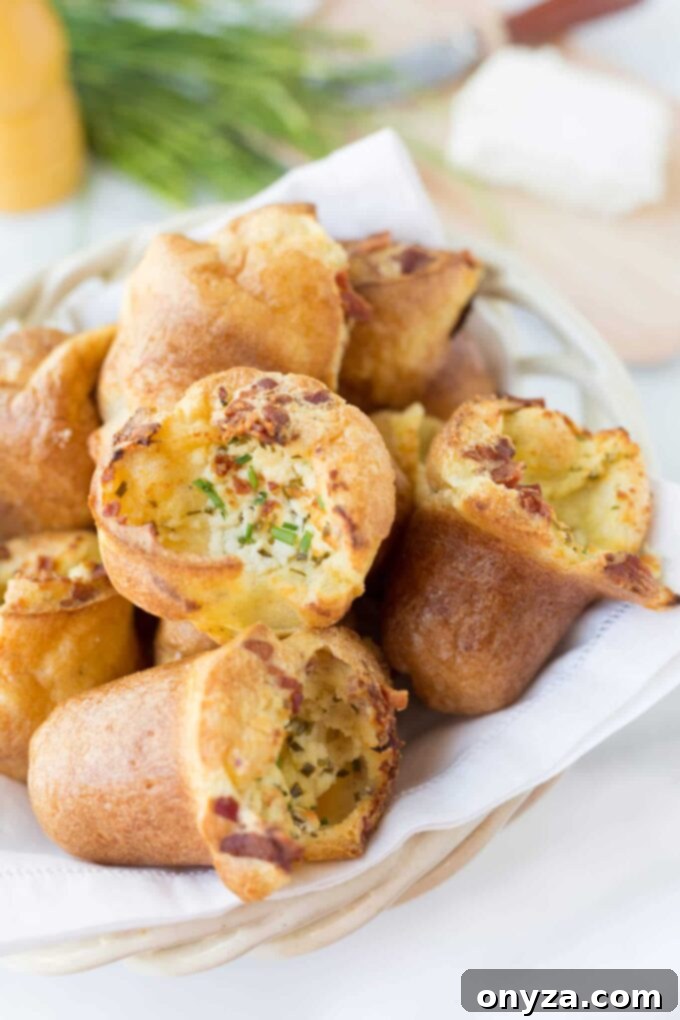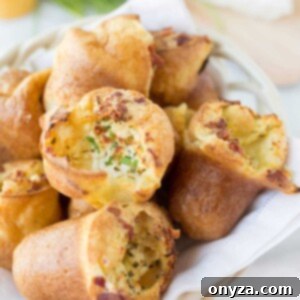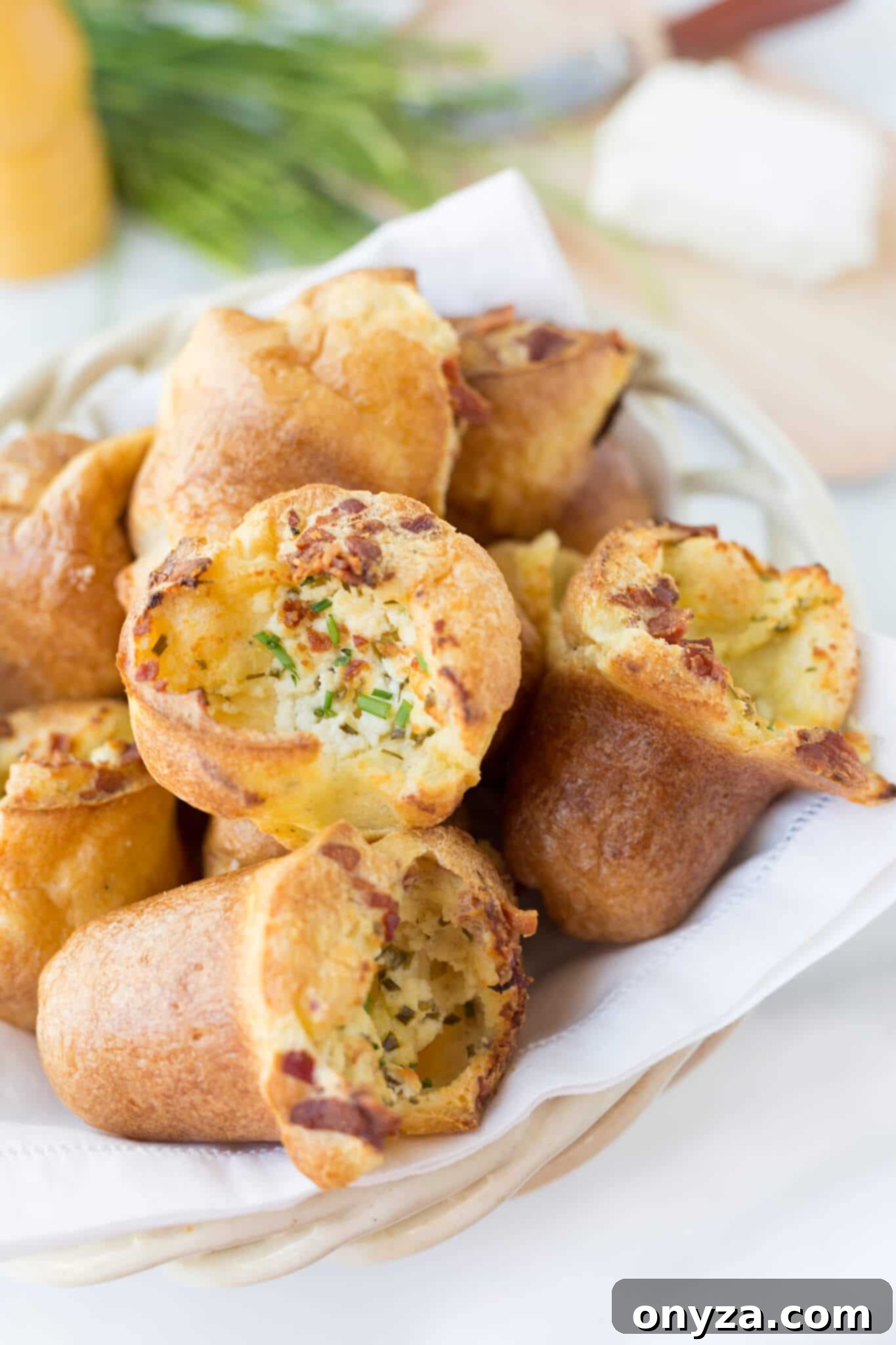Welcome to the delightful world of popovers! These light, airy, and utterly delicious rolls, featuring a crisp exterior and a wonderfully hollow interior, are a culinary marvel. This particular recipe elevates the classic popover to new heights by infusing it with the rich flavors of savory bacon and creamy goat cheese. Perfect for any occasion, from a luxurious brunch to an elegant dinner side, these Bacon and Goat Cheese Popovers are guaranteed to impress. Their simple preparation belies their sophisticated taste, making them an ideal addition to your bread basket or a standalone treat.

This post contains affiliate links. As an Amazon Associate, I earn a commission (at no additional cost to you) from qualifying purchases made by clicking these links. As always, all recommendations and opinions expressed are my own.
The Allure of Popovers: A Culinary Delight
Popovers have a unique charm that transcends seasons, yet they truly shine as a light and inviting treat, especially in spring. The contrast between their puffed, golden-brown shells and the incredibly tender, almost ethereal interiors is simply irresistible. For many, including myself, popovers evoke cherished childhood memories. I recall watching with fascination as my mother pulled these “magical” rolls from the oven, ballooning dramatically as if by enchantment. It was always a moment of pure wonder, a testament to the simple joys of home baking.
Traditionally, these warm, delightful rolls were often served with sweet accompaniments like butter and honey, or even strawberry butter for a special touch. While these classic pairings are undoubtedly delicious, my culinary journey has led me to explore exciting savory variations. Over the years, I’ve experimented with diverse flavor combinations to match different seasons, and for spring, nothing complements the lightness of a popover quite like the bright tang of goat cheese. This recipe perfectly marries the delicate structure of a popover with the sophisticated blend of salty bacon, creamy goat cheese, aromatic fresh chives, and a hint of freshly ground black pepper.

These savory Popovers with Goat Cheese and Bacon are not just light-textured and full-flavored; they are incredibly versatile. Whether you’re planning a leisurely breakfast, a hearty brunch, a light lunch, or serving them as an accompaniment to dinner, they fit seamlessly into any meal plan. Their elegance and ease of preparation make them a fantastic choice for entertaining or simply elevating an everyday meal.
Understanding Popovers: The Science Behind the “Pop”
The name “popover” is beautifully descriptive, referring to how the batter dramatically rises and “pops” over the tops of the baking wells during cooking. It’s a truly captivating sight, especially when you consider that you start with just a few tablespoons of thin batter in each well. The rapid expansion and impressive height achieved are a key part of their appeal and a testament to the simple yet effective science at play.
At their core, popovers are closely related to British Yorkshire puddings. Both baked goods share a foundational batter made from milk, eggs, flour, and salt. The primary difference often lies in the fat used; Yorkshire puddings traditionally bake in the savory drippings from roasted meats, lending them a distinct umami flavor, while popovers typically use melted butter or cooking spray. This basic yet potent combination of ingredients, when subjected to high heat, creates the steam necessary for their signature rise and airy, hollow interior.
The “magic” of a popover’s rise is a beautiful example of basic physics in the kitchen. When the thin, liquid-rich batter hits a preheated, very hot pan, the water in the milk and eggs rapidly converts into steam. This steam expands quickly, forcing the batter upwards and outwards against the pan’s sides, creating the characteristic puffed-up shape. As the exterior bakes and sets, it forms a crisp crust that encapsulates the steam, while the interior remains moist and tender until it ultimately becomes hollow. This dramatic transformation is what makes popovers such a unique and delightful bread.
Crafting the Perfect Popover: Techniques for Success
While some recipes might suggest using a blender for convenience, I’ve consistently found that hand-mixing the batter with a whisk yields a superior, more tender final product. The gentle action of a whisk helps to avoid overmixing the gluten in the flour, which can lead to tough popovers. Plus, it takes hardly any extra time, making it a small effort for a significant improvement in texture.
The popover batter is intentionally thin, usually resembling the consistency somewhere between half-and-half and heavy cream. This isn’t a mistake; it’s a crucial element in their success. The high liquid content is what generates the substantial amount of steam required during baking. This steam is the driving force behind the dramatic rise, the puffing, and the creation of that wonderfully hollow center that defines a classic popover. Achieving this specific batter consistency is key to unlocking the full potential of these delightful rolls.
Homemade Popovers: Essential Tips for an Impeccable Result
To ensure your bacon and goat cheese popovers achieve the most glorious rise and ideal texture, keep these critical best practices in mind:
- Preheat Your Pan: Your popover pan or muffin tin must be preheated along with your oven. Pouring the batter into hot wells creates an immediate burst of steam, which is fundamental for the impressive rise. Cold pans will result in denser, shorter popovers.
- Room Temperature Ingredients are Key: Ensure both your eggs and milk are at room temperature. Cold ingredients can shock the batter and prevent it from rising as effectively, leading to a less airy texture. If you’re short on time, gently warm the milk in the microwave (not hot!) and place the eggs in a bowl of warm water for about 10 minutes.
- Start Hot, Then Reduce: Begin baking your popovers in an extra-hot oven (425 degrees F). This initial burst of high heat encourages maximum steam production and rapid expansion. After they’ve “popped” and started to set (usually around 20 minutes), reduce the oven temperature (to 350 degrees F) to allow them to continue baking through and achieve a beautiful golden color without burning. The deeper the golden color, the better they tend to retain their shape after baking.
- Resist the Urge to Peek: This is perhaps the most challenging, yet crucial, rule: do not open the oven door during baking, especially in the first 20-25 minutes. Opening the door causes a sudden drop in temperature, which can deflate your popovers and prevent them from reaching their full, glorious height.
- Protect Your Oven: When working with fillings like the creamy goat cheese in this recipe, it’s wise to place your popover pan on a lined baking sheet. As the batter rises and the cheese melts, it’s almost inevitable that a small amount of cheese might bubble out of the wells. The baking sheet will catch any drips, saving you from a messy oven cleanup.
- Serve Immediately for Best Texture: Much like delicate soufflés, popovers are at their absolute best when served immediately after baking. As soon as they emerge from the oven, use the tip of a sharp knife to pierce the top or side of each popover. This allows the trapped steam to escape, which helps them maintain their crisp texture and prevents them from becoming soggy.
- Don’t Overmix the Batter: Whisk the batter just until the ingredients are combined and only small lumps of flour remain. Overmixing develops the gluten too much, resulting in a tough, chewy popover rather than a light and tender one. A few lumps are perfectly fine!
- Accurate Measurements: Baking is a science, and popovers are particularly sensitive to ingredient ratios. Use proper measuring cups and spoons, and for flour, spoon it into your measuring cup and level it off rather than scooping directly, which can compact the flour and lead to too much being used.
(Note: It’s worth observing that plain popovers tend to crown a bit more in the center compared to those filled with ingredients like goat cheese. This is simply because the batter naturally balloons around the filling, creating a slightly different, though equally delightful, shape.)
Popover Pan vs. Muffin Tin: Choosing Your Bakeware
If you’re wondering if a specialized popover pan is essential, the answer is nuanced. While a dedicated popover pan, like the 12-cup mini popover pan used here, will undeniably encourage the tallest and most dramatic rise due to its deeper, straight-sided wells, a standard muffin tin works remarkably well as an alternative. Popover pans are designed to funnel the batter upwards, maximizing the “pop” effect and creating those distinctively tall, often slender, forms with ample hollow space.
When baked in a muffin tin, your popovers will naturally be shorter and a bit wider, resembling more of a puffy muffin shape. However, this doesn’t diminish their deliciousness or airy texture. They still offer the delightful crisp exterior and tender interior that makes popovers so beloved. So, don’t let the lack of a specialized pan deter you from trying this fantastic recipe. You can achieve excellent results with equipment you likely already own.
For further reading and a deeper dive into the necessity of specialized pans, consider exploring resources like “Popover Pans: Are They Necessary for Perfect Popovers?” from Kitchn. Ultimately, the goal is a delicious, airy roll, and whether it’s from a popover pan or a muffin tin, the enjoyment is guaranteed. The joy of bringing a gorgeous basket of these popovers to the table is an easy way to make any meal feel a little more special. Just whisk, fill, and bake!
Chef’s Tip: Streamline your prep by baking your bacon! Oven-baked bacon cooks evenly to a perfect crisp, making it effortless to crumble, and cleanup is a breeze. For detailed instructions, check out my How to Cook Bacon in the Oven tutorial.
Serving Suggestions and Perfect Pairings
These savory Bacon and Goat Cheese Popovers are incredibly versatile and can enhance a variety of meals. For a delightful brunch, serve them alongside scrambled eggs, a fresh fruit salad, or a quiche. They also make a fantastic addition to a dinner table, pairing beautifully with roasted chicken, a hearty soup, or a light spring salad. Imagine them as an appetizer, served warm with a glass of crisp white wine, or as a sophisticated accompaniment to a cheese board. The tangy goat cheese and salty bacon offer a rich depth of flavor that complements both casual and elegant dining experiences.
Explore More Spring Goat Cheese Recipes
If you’ve fallen in love with the vibrant flavor of goat cheese in these popovers, you’ll be thrilled to discover its versatility in other spring dishes. Goat cheese brings a creamy, tangy dimension that brightens up a variety of recipes. Here are a few more delightful spring recipes featuring goat cheese that you might enjoy:
- Whipped Goat Cheese and Herb Dip: A light and refreshing dip perfect for crudités or crackers, bursting with fresh herbs.
- Goat Cheese and Roasted Cauliflower Soufflés: An elegant and surprisingly simple dish, these soufflés combine the earthiness of roasted cauliflower with the creamy tang of goat cheese.
- Mixed Citrus Salad with Honey-Balsamic Vinaigrette and Goat Cheese: A vibrant salad that balances sweet citrus with the sharp notes of goat cheese, all tied together with a delicate vinaigrette.

Pin Recipe
Print Recipe
Popovers Recipe with Bacon and Goat Cheese
Ingredients
- 1 cup milk, room temperature
- 3 strips bacon, cooked crisp and crumbled
- 1 tablespoon chopped fresh chives
- 3 ounces goat cheese
- 1 tablespoon unsalted butter, melted and cooled slightly
- ½ teaspoon freshly-ground black pepper
- ¾ teaspoon kosher salt
- 1 cup all-purpose flour
- 2 large eggs, room temperature
- cooking spray, for greasing pans
Instructions
- Preheat oven to 425 degrees F with a rack in the lower third of the oven. Place a 12-well popover pan (recommended) or a standard, nonstick 12-cup muffin tin onto a lined baking sheet in the oven to preheat.
- In a small bowl, gently stir together the goat cheese and fresh chives. Set this mixture aside. Measure out the flour, kosher salt, and black pepper, and set them aside as well.
- In a large mixing bowl, vigorously whisk together the room temperature milk and eggs until the mixture becomes light and frothy, which typically takes about 1-2 minutes. Add the measured flour, salt, and pepper to the wet ingredients and whisk just until they are combined and only small lumps of flour remain. Finally, whisk in the slightly cooled melted butter. The resulting batter should be relatively thin, with a consistency similar to light cream.
- Carefully remove the hot popover pan from the oven and thoroughly coat each well with cooking spray. Fill each well about halfway with the prepared popover batter. Into the center of each filled well, spoon approximately 1 teaspoon of the goat cheese and chive mixture, then sprinkle generously with some of the crumbled cooked bacon.
- Return the pan to the oven and bake for 20 minutes at 425 degrees F. After 20 minutes, without opening the oven door if possible, reduce the oven temperature to 350 degrees F and continue baking for an additional 15 minutes, or until the popovers are golden brown and their tops appear dry and set. They will have risen considerably and should look beautifully puffed.
- Immediately upon removing the popovers from the oven, carefully take them out of the pan. Use a sharp knife to pierce the sides or tops of each popover. This crucial step allows the trapped steam to escape, which helps them maintain their crisp exterior and prevents them from becoming soggy. For the crispiest and most delightful texture, serve them immediately while they are still warm.
Notes
Nutrition Estimate (per popover)
Nutrition information is automatically calculated, so should only be used as an approximation.
Please note that our recipes have been developed using the US Customary measurement system and have not been tested for high altitude/elevation cooking and baking.
*Post originally published April 20, 2016. Updated and re-edited for clarity and SEO.
